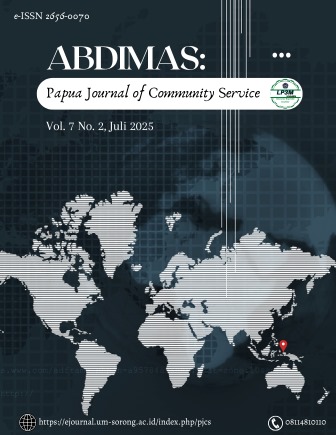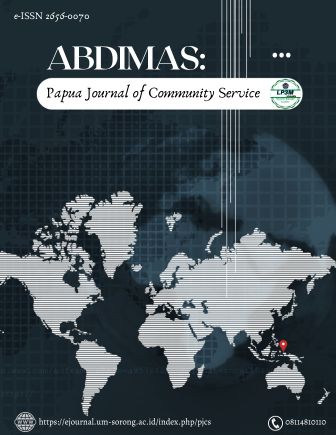Socialization of Coral Reef Conservation Based On Biorock Technology
DOI:
https://doi.org/10.33506/pjcs.v7i2.4639Keywords:
socialization, coral reefs, Education, Biorock technology, environmental conservation, environmental educationAbstract
The socialization activity on coral reef conservation using Biorock technology was conducted at MA Emayodere Sorong as an environmental education initiative for the younger generation. The purpose of this activity was to enhance students’ understanding and awareness of the importance of marine ecosystem conservation, particularly coral reefs, and to introduce Biorock technology as an innovative solution for reef rehabilitation. The activities were carried out through interactive presentations, group discussions, and evaluations using pre-tests and post-tests. The results showed a significant improvement in students’ understanding. The average pre-test score of 55 increased to 82 in the post-test, representing a 27-point or 49% improvement. A total of 88% of the students expressed increased concern for marine environmental issues, and 72% showed interest in participating in conservation actions. This activity demonstrates that an educational approach combining technology and participation can effectively foster environmental awareness among students. Therefore, the socialization of coral reef conservation using Biorock technology is not only effective in enhancing students’ knowledge but also holds the potential to create young environmental change agents. Such activities should be continued sustainably with cross-sectoral support to protect marine ecosystems.
References
Burke, L., Reytar, K., Spalding, M., & Perry, A. (2011). Reefs at Risk Revisited. World Resources Institute.
Goreau, T. J., & Hilbertz, W. (2005). Marine ecosystem restoration: costs and benefits for coral reefs. Journal of Oceanography, 12(3), 124-131.
Hassanshahian, M., Riazi, A., & Rahmani, M. (2022). Digital learning strategies in environmental education: A review of trends and impacts. Environmental Education Research, 28(6), 879-895.
Hilbertz, W., & Goreau, T. J. (1996). Biorock: A method of growing limestone reefs, fisheries habitats, and shorelines. Global Coral Reef Alliance.
Hughes, T. P., et al. (2017). Global warming and recurrent mass bleaching of corals. Nature, 543(7645), 373–377.
Kementerian Kelautan dan Perikanan (KKP). (2021). Statistik Sumber Daya Laut dan Pesisir Indonesia.
Rani, C., & Nasution, Z. (2021). Teknologi Biorock dalam Restorasi Terumbu Karang: Studi Kasus di Gili Trawangan. Jurnal Ilmu Kelautan Tropis, 8(2), 75-84.
Spalding, M. D., Ravilious, C., & Green, E. P. (2001). World Atlas of Coral Reefs. University of California Press.

Downloads
Published
Issue
Section
License

This work is licensed under a Creative Commons Attribution-ShareAlike 4.0 International License.
Authors who publish with this journal agree to the following terms:
Authors retain copyright and grant the journal right of first publication with the work simultaneously licensed under a Creative Commons Attribution-ShareAlike 4.0 International License. that allows others to share the work with an acknowledgment of the work's authorship and initial publication in this journal.
Authors are able to enter into separate, additional contractual arrangements for the non-exclusive distribution of the journal's published version of the work (e.g., post it to an institutional repository or publish it in a book), with an acknowledgment of its initial publication in this journal.
Authors are permitted and encouraged to post their work online (e.g., in institutional repositories or on their website) prior to and during the submission process, as it can lead to productive exchanges, as well as earlier and greater citation of published work

Papua Journal of Community Service is licensed under a Creative Commons Attribution-ShareAlike 4.0 International License



